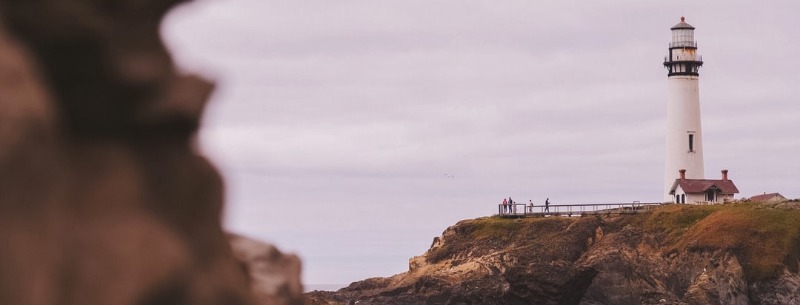NC Lighthouses Guide
Lighthouses of NC Outer Banks
Throughout history, lighthouses around the world have come to represent the adventure and mystery of ships at sea and the lovers waiting for them to return. Well, the same holds true of the North Carolina lighthouses as well.
There are said to be eight lighthouses on the North Carolina coast but I have also heard of a ninth, yet I have not been there myself. Of course, I am looking into this and will report my findings as soon as I can verify if it is true. I must tell you though, that I do believe that the ninth lighthouse is the replica of the Roanoke River Lighthouse.
All of the lighthouses have their own story to tell and as you may imagine, they are not only exciting but they offer up plenty of historical meaning to attract the history buffs and the romantics alike.
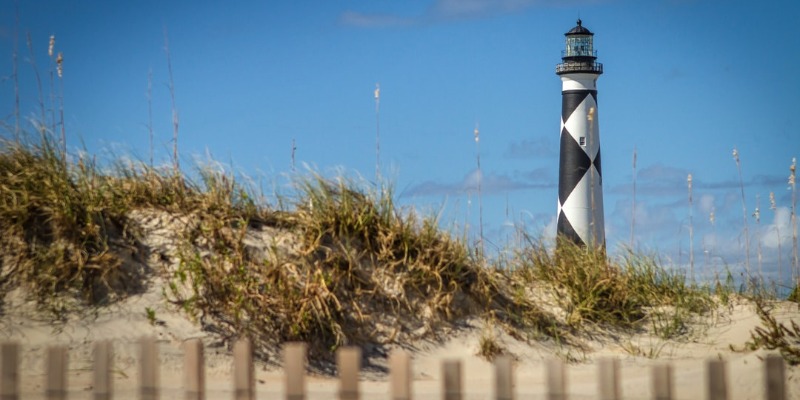
Currituck Lighthouse
If you like North Carolina lighthouses, you’ll want to tour all of the ones here in North Carolina. We loved our visit to Currituck lighthouse. As a matter of fact, we loved seeing all the lighthouses! There is just something about it. The history, romance, and adventure make it a great vacation spot!
 The lighthouse sits in the most northern corner of North Carolina, located in the village of Corolla along the Outer Banks.
The lighthouse sits in the most northern corner of North Carolina, located in the village of Corolla along the Outer Banks.
Although the other lighthouses along the North Carolina Coast have all be painted, Currituck stands out because of it’s natural brick appearance. Most people don’t know about the most interesting North Carolina facts.
This lighthouse was actually built because of the forty-mile stretch of dark waters between the Bodie Island lighthouse, NC, and Cape Henry, Virginia. It was because so many ships became victims of the treacherous waters in this area that the lighthouse was not an option but a necessity. It was lit on December 1, 1875, and to look at it, you would be amazed at just how many bricks were used to create this beautiful lighthouse.
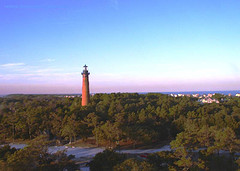
It is an amazing looking lighthouse and the best part is…it’s open to the public. For us, that means we have the opportunity to walk the breathtaking grounds, or for a nominal fee, climb to the top and check out the amazing views!
Did I mention that this Currituck Beach Lighthouse is automated? It was automated in 1939 and at that time the keepers were no longer needed to keep up the duties they were there for, such as cleaning lenses, trimming wicks, and fueling the lamps, as well as some of the other duties they tended to.
Currituck Lighthouse Facts
- Number of steps: 214 Height to the focal plane of lens: 158 feet
- Height to top of roof: 162 feet
- Number of bricks: approximately one million
- The thickness of the wall at base: 5 feet 8 inches
- The thickness of the wall at parapet: 3 feet
- Position: 34 miles south of the Cape Henry (Virginia) Lighthouse 32 1/2 miles north-northwest of Bodie Island Lighthouse.
Like the other lighthouses on North Carolina’s Outer Banks, this one still serves as an aid to navigation. The beacon comes on automatically every evening at dusk and ceases at dawn.
Bodie Island Lighthouse
The Bodie Island Lighthouse is known for its trademark painted black and white striped bands and stands 150 feet tall.
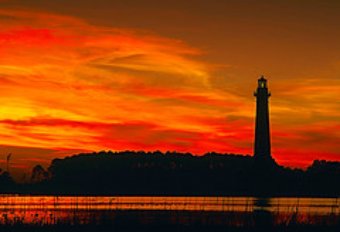 It was built in 1872 but is one of the North Carolina lighthouses, that has been under construction more than once. It is actually the third Bodie Island Lighthouse that has been constructed. The first, lit in 1848, was very poorly constructed due to, what else, saving money! Listen to this, it was built with such a weak foundation that one side of it actually started sinking.
It was built in 1872 but is one of the North Carolina lighthouses, that has been under construction more than once. It is actually the third Bodie Island Lighthouse that has been constructed. The first, lit in 1848, was very poorly constructed due to, what else, saving money! Listen to this, it was built with such a weak foundation that one side of it actually started sinking.
They must have learned their lesson from that because the second one was built very sturdy. So what happened? Well, the Civil War happened and when the Confederates were forced to retreat, well, they blew it up, just so the Union Navy wouldn’t be able to use it. Talk about a temper tantrum! That was in 1861.
Bodie Island Lighthouse Facts & Trivia
Bodie Island was said to have originally been named “Body” after the landowners, but some myths that are floating around say that it was named “Body” due to the many shipwrecks and the bodies that were seen in the waters. But that is not the only interesting thing about the North Carolina Lighthouses.
Not many people know that huge flock geese crashed into the lens and they had to put a screen around it to protect it from additional bird collisions. Or that the spiral staircase had originally been attached to a metal rod that held a lantern that served as a lightning conductor.
Can you guess what happened?
One of the keepers was on the landing during a storm and received a shock, so strong that it actually left the lower part of his body numb! I know! It’s amazing that he even survived! This lighthouse is also automated but because it’s needed for renovation, visitors may not go inside or climb this lighthouse. There is a visitor’s center where you can buy books and various items to remember your visit.
Cape Hatteras Lighthouse
As the tallest of all the North Carolina lighthouses, Cape Hatteras Lighthouse has warned sailors for more than one hundred years about the shallow sandbar that extends about fourteen miles from the shore into the ocean. The light itself can be seen from twenty miles out in the ocean. As ships attempted to navigate the North Carolina coast, The Diamond Shoals, which is an ever-changing series of shallow underwater sandbars, proved not to be the only challenge.
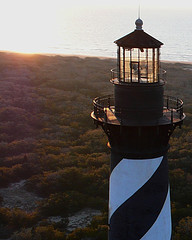 This area is also known for the two strong currents that collide off Ocracoke and Hatteras islands that make it difficult for vessels to navigate unless coming very close to the Outer Banks North Carolina. Now, this wasn’t always hazardous, but as we know, the North Carolina coast brings with it strong winds and severe storms and if a ship happened to be overpowered by nature, it could prove to be a deadly decision as we know from North Carolina history.
This area is also known for the two strong currents that collide off Ocracoke and Hatteras islands that make it difficult for vessels to navigate unless coming very close to the Outer Banks North Carolina. Now, this wasn’t always hazardous, but as we know, the North Carolina coast brings with it strong winds and severe storms and if a ship happened to be overpowered by nature, it could prove to be a deadly decision as we know from North Carolina history.
What makes it worse is that there are no natural landmarks, so boats are actually grounded and in trouble before they even know what has happened!
The ships that have been lost near Cape Hatteras is estimated at over a thousand. These vessels are at rest now in what is known as the Graveyard of the Atlantic.
Some of the shipwrecked sailors decided to stay, making Cape Hatteras their home. This gave those crafts a legacy that endures even today.
Could those ships have been saved?
Possibly, but just knowing the dangerous situation doesn’t always prevent it.
Has the lighthouse done a good job?
Most would respond with a big YES! This is why it remains one of the most popular North Carolina attractions, along with the beaches in North Carolina, of course! Cape Hatteras Lighthouse is donned in black and white bands, but with a twist…literally! A story I have heard is that the engineer that was assigned the task of painting the lighthouses of North Carolina got the plans mixed up!
Cape Hatteras Lighthouse Facts
The Cape Hatteras Lighthouse was originally supposed to be painted with black and white diamonds, to warn of the Diamond Shoals. Makes sense, right?
Well, Apparently not! The diamonds were painted on the lighthouse at Cape Lookout and the lighthouse at Cape Hatteras got black and white spiral bands, giving it the name “The Big Barber Pole.”
The lighthouse is open to the public from April until mid-October. But if you are planning to climb up to see the spectacular views, be sure to get yourself into a training program before you come. There are two-hundred sixty-eight steps.
Ocracoke Lighthouse
We loved visiting the Ocracoke Lighthouse! We had a perfect day when we came to see this lighthouse. As a lighthouse buff, I enjoy learning all I can about the history of each lighthouse. The fact that this is the oldest one in operation gave me a lot to think about. All the adventures at sea…it really get the imagination rolling.
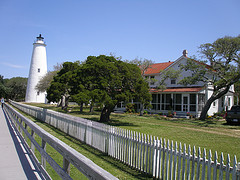 Ocracoke Lighthouse sits on the Island’s highest spots, yet it is the shortest of all the North Carolina lighthouses. It is also the oldest still in operation, having been built in 1823. Many people want to dispute this, arguing that Bald Head Lighthouse is the oldest, and that is true, but they don’t take it into consideration that the Ocracoke has operated continuously where Bald Head is no longer active.
Ocracoke Lighthouse sits on the Island’s highest spots, yet it is the shortest of all the North Carolina lighthouses. It is also the oldest still in operation, having been built in 1823. Many people want to dispute this, arguing that Bald Head Lighthouse is the oldest, and that is true, but they don’t take it into consideration that the Ocracoke has operated continuously where Bald Head is no longer active.
Ocracoke Island is accessible only by air and water. It’s located on one of the barrier islands of the Outer Banks North Carolina where Blackbeard, Yes, the Pirate, once hung out.
… or was he hiding out?
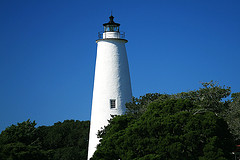 Having survived many, many hurricanes, the worst one on record is the hurricane of 1944 when water flooded the entire island and with some reporting in excess of twenty-five inches of water in their homes!
Having survived many, many hurricanes, the worst one on record is the hurricane of 1944 when water flooded the entire island and with some reporting in excess of twenty-five inches of water in their homes!
The lighthouse was automated in 1946 and still guides ships between Ocracoke and Portsmouth Islands today.
Unfortunately, it is not open to the public. But come anyway! Just down the street, there is an adorable general store where you can buy gifts and memorabilia.
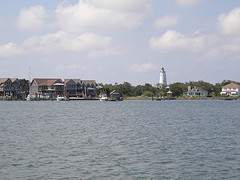 The best way to see the island is either by foot or on a bicycle. Yes, I did say bicycle. You can also rent a kayak and have a guide take you on a tour or if you are the adventurous type, explore on your own.
The best way to see the island is either by foot or on a bicycle. Yes, I did say bicycle. You can also rent a kayak and have a guide take you on a tour or if you are the adventurous type, explore on your own.
But don’t let that stop you from visiting Ocracoke Island, there is plenty to see and do. Check out the British Cemetery, gift shops, trails, and of course, the restaurants. This is one of North Carolina’s great vacation spots
Oak Island Lighthouse
Oak Island Lighthouse is called the most powerful in America, as it can be seen for twenty-four miles out to sea!
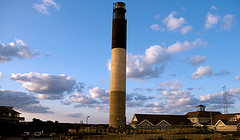 It was activated in 1958 and is still in operation today. It stands one hundred forty-eight feet tall, although a mistaken belief is that it is one hundred sixty-nine feet tall. In reality, it stands on a rise, so the lighthouse is one hundred sixty-nine feet above the water.
It was activated in 1958 and is still in operation today. It stands one hundred forty-eight feet tall, although a mistaken belief is that it is one hundred sixty-nine feet tall. In reality, it stands on a rise, so the lighthouse is one hundred sixty-nine feet above the water.
Located on Caswell Beach at the U.S Coast Guard station, the lighthouse is not open to the public. Marked by its three bands colored black at the top, white in the middle and grey at the bottom, but unlike most North Carolina lighthouses, there is no spiral staircase. Instead, there are ships ladders that offer a climb of over one hundred thirty steps to the top.
Oak Island Lighthouse Facts
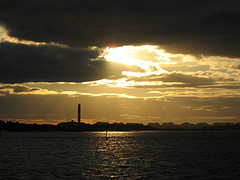 This Lighthouse was one of the last built along the North Carolina coast, and at the time it was constructed, it cost $110,000.00. The great thing about the lighthouse is that you can get a tour. Your tour guide will tell you all about the history of the lighthouse and tell you some things you won’t find out anywhere else. There is also access to the boardwalk and an observation deck.
This Lighthouse was one of the last built along the North Carolina coast, and at the time it was constructed, it cost $110,000.00. The great thing about the lighthouse is that you can get a tour. Your tour guide will tell you all about the history of the lighthouse and tell you some things you won’t find out anywhere else. There is also access to the boardwalk and an observation deck.
Cape Lookout Lighthouse
Cape Lookout Lighthouse was lit on the first of November in 1859. It was not the original lighthouse, but a second chance to make it a success as one of the North Carolina lighthouses. The first attempt was riddled with problems that included the fact that it was just too short to help the seamen, as well as having a light too dim to see in bad weather when it was needed most.
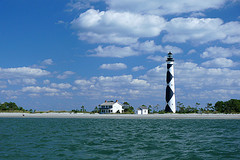 Many of the North Carolina lighthouses along the Outer Banks had to be rebuilt for one reason or another and Cape Lookout was one of them. This one became the example that the rest would eventually follow. The new lighthouse stood at 163 feet tall where the original was only 96 feet tall. Those sixty-seven feet made a very big difference in how it was able to do its job!
Many of the North Carolina lighthouses along the Outer Banks had to be rebuilt for one reason or another and Cape Lookout was one of them. This one became the example that the rest would eventually follow. The new lighthouse stood at 163 feet tall where the original was only 96 feet tall. Those sixty-seven feet made a very big difference in how it was able to do its job!
It was re-built strong with a bright light that could be seen for nineteen miles out, even in the worst rainstorms. You will know the Cape Lookout tower at by its trademark black and white diamonds that were originally meant for another lighthouse!
Yes, you guessed it! The diamonds were meant for The Cape Hatteras Lighthouse to warn of the Diamond Shoals.
If things had gone as planned, you would be looking at a Cape Lookout lighthouse with spiraled black and white bands.
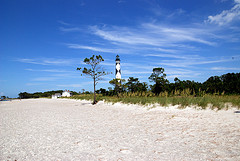 Most of the lighthouses along the Outer Banks were planned so that once a light was out of sight a new one would soon come into view. It was because of the many shoals that the North Carolina lighthouses were built, attempting to keep sailors safe and warn them of the existing danger along the Outer Banks North Carolina.
Most of the lighthouses along the Outer Banks were planned so that once a light was out of sight a new one would soon come into view. It was because of the many shoals that the North Carolina lighthouses were built, attempting to keep sailors safe and warn them of the existing danger along the Outer Banks North Carolina.
Cape Lookout Lighthouse Facts
Although the Cape Lookout lighthouse is considered nearly perfect in design, there is one defect that still has not been repaired. When it was built, the stairwell was not anchored properly to the side of the wall and tended to be weak with repairs needed often. So today, this lighthouse is not open to the public.
It sure would have been nice to climb up and take in the great views. The beauty of this lighthouse and the Cape Lookout seashore make this a must-see on any North Carolina vacation and a great vacation spot to visit.
Bald Head Lighthouse
The first lighthouse on North Carolina’s Outer Banks, Bald Head Lighthouse was built to mark the Bald Head Shoals.
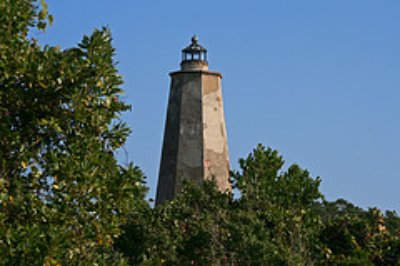
One of the North Carolina facts you may not know is that along the island, the dunes became worn down and looked like a bald head, and that’s how it became known as “Old Baldy”.
The lighthouse stands on the point of the treacherous waters, where you can view on a map of North Carolina along the Outer Banks called the Graveyard of the Atlantic which marks the way for ships heading into the Cape Fear River. It was built in 1818 and yes, it does replace an even older structure. The first of which had been built in 1796 and had been destroyed by erosion of the beaches in North Carolina.
The lighthouse that stands today is 109 feet tall and is an octagonal tower made of brick and cement. In 1935 it was decommissioned due to shifting shoals which made it obsolete.
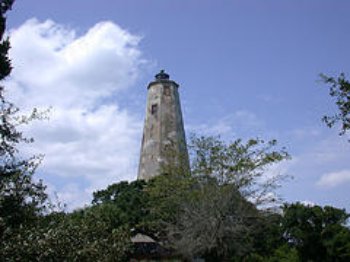
The good news…you can still climb the tower. It’s a great vacation spot for families to visit, along with the other North Carolina lighthouses, such as the oak island lighthouse, the Currituck Lighthouse, Bodie Island lighthouse, Cape Hatteras lighthouse, Cape Lookout lighthouse, Oak Island lighthouse, and the Prices Creek lighthouse.
In order to see this historic lighthouse, you have to understand there is one way to get here. By boat!
Is it worth it? You bet it is. Although if you are used to traveling by car, you might want to make other plans. Only bikes, skates, golf carts, and your own feet are going to get you around here. But by leaving your car behind, you also leave the exhaust, horns, and traffic as well.
Prices Creek Lighthouse
I have to be honest, the Prices Creek Lighthouse was not as impressive as most and since it is located on private property, you have to see it by boat. So, be sure you have a beautiful day and…you like boats. Built in 1849, this Lighthouse was never again lit after the Civil War. It only stood twenty feet but was one of the seven North Carolina lighthouses that lit the way for sailors along the North Carolina Coast.
During the Civil War, it was used as a confederate Station and although the other lighthouses were destroyed when the confederates lost control over the rivers, this one was spared. Going to see this little light is not easy.
Since the lighthouse is on private property, it makes it difficult to get up close. So, if you really want to see it, you’re going to have to see it from the water. The ferry at Southport is the place to get the best view.
More Info on NC Lighthouses
Lighthouses of North Carolina
A great book to read if you love lighthouses and want to know more is Bansemer’s Book of Carolina and Georgia Lighthouses. It’s very informative and along with his friendly writing style, you feel like your speaking with a friend, it also has some beautiful pictures that add so much to the overall history of lighthouses.
I highly recommend this book if you’re planning to do a lighthouse tour. You can visit the lighthouses any time of year but if you want to get inside, which I highly recommend. You will need to call the lighthouses you want to see and ask. Most are open for visits from spring until late fall.
